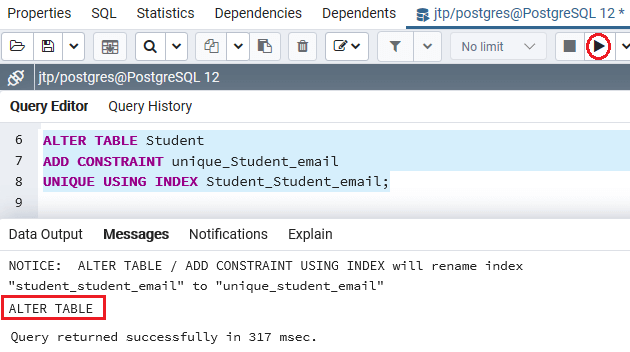

The takeaway: if you’re dealing with from/to ranges give exclusion constraints a closer look. A better option would be having the unique index that filters all the deleted records:ĪLTER TABLE billings ADD CONSTRAINT billings_excl EXCLUDE USING gist ( id WITH =, period WITH & )
#Postgresql constraint code#
But, if you have some logic in your code to do soft deletes instead of hard deletes, you now have a problem that a user that has deleted_at set to a timestamp then that user cannot come back in and recreate an account. Usually you would have a unique constraint on your email column. Unique indexes or constraints are common. Let’s take a look at a few of the various types of database constraints we can create to ensure data correctness: Partial unique indexes Constraints are essentially rules that your data has to follow. And when it comes to your database, constraints are the last line of defense. So as I thought it would be worthwhile to write-up, and here you go: Enter constraints.Ĭonstraints are an extremely powerful construct for your database.

As it’s always great to get out in person and chat with people about Postgres and their experience in scaling their database, many remarked that the talk could be useful to others that weren’t there. The conference itself was a great local event in Paris, and while there we had a chance to meet with a few of our customers based in Paris as well. This post was the result of a recent talk I recently gave at PgDay Paris. Because it changes less frequently the case can easily be made that spending some time to ensure correctness at the database level is a great return on time.

Going further, your database schema and models are going to change far less than your application code.

Protecting that data and ensuring it’s both safely stored but also correct is worth the time investment because of the value it has. At least not for your one source of truth. Once it’s stored it’s not likely to be actively moved or frequently modified. It consists of the field called order_id.Data has a certain gravity and inertia. In this example, we've created a unique constraint on the existing order_details table called order_unique. ALTER TABLE order_detailsĪDD CONSTRAINT order_unique UNIQUE (order_id)
#Postgresql constraint how to#
Let's look at an example of how to add a unique constraint to an existing table in PostgreSQL using the ALTER TABLE statement. column_n The columns that make up the unique constraint. constraint_name The name of the unique constraint. This is the table that you wish to add a unique constraint to. column_n) table_name The name of the table to modify. The syntax for creating a unique constraint using an ALTER TABLE statement in PostgreSQL is: ALTER TABLE table_nameĪDD CONSTRAINT constraint_name UNIQUE (column1, column2. We could also create a unique constraint with more than one field as in the example below: CREATE TABLE order_detailsĬONSTRAINT order_date_unique UNIQUE (order_id, order_date)Ĭreate unique contraint - Using an ALTER TABLE statement It consists of only one field - the order_id field. In this example, we've created a unique constraint on the order_details table called order_unique. ( order_detail_id integer CONSTRAINT order_details_pk PRIMARY KEY,ĬONSTRAINT order_unique UNIQUE (order_id) Let's look at an example of how to create a unique constraint in PostgreSQL using the CREATE TABLE statement. uc_col_n The columns that make up the unique constraint. column1, column2 The columns that you wish to create in the table. ) table_name The name of the table that you wish to create. The syntax for creating a unique constraint using a CREATE TABLE statement in PostgreSQL is: CREATE TABLE table_nameĬONSTRAINT constraint_name UNIQUE (uc_col1, uc_col2. Create unique Contraint - Using a CREATE TABLE statement


 0 kommentar(er)
0 kommentar(er)
